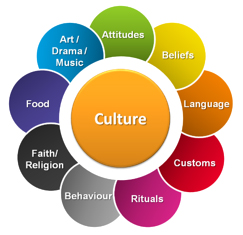Online Course
Nurs 787 - Theory Teaching and Learning
Module 2: Contexts of Learning and Learner Characteristics
Cultural Differences
Culture is not merely a skin color or country of origin. Rather, as defined in the Cambridge Dictionary, is a way of life, including customs and beliefs, of a group of people at a particular time. The definitions provided in Bastable, Chapter 8 expand on this definition and offer a foundation for consideration of cultural attributes of the learner.

In nursing and health care, the Giger and Davidhizar assessment model described in your reading identifies six components of the individual:
| Communication | Social organization | Biological variation |
| Personal space | Environmental control | Time |
This model is widely used in cultural considerations relating not only to patient care, but also in education. Understanding differences in learning across cultures relies heavily on communication.
What are some considerations in cultural assessment?
- A resource for working with learners for whom English is a second language is the English for Speakers of Other Language (ESOL) at the Baltimore City Community College.
- “The Purnell Model for Cultural Competence was developed by Larry D. Purnell and Betty J. Paulanka, as an outline to classify and arrange elements that have an effect on the culture of an individual. The framework uses an ethnographic method to encourage cultural awareness and appreciation in relation to healthcare. To review the article click here.